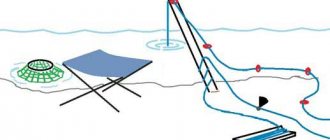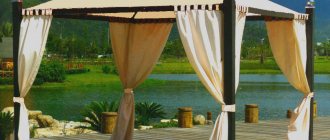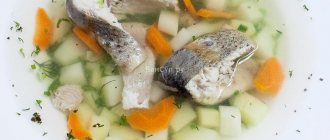Requirements for an anchor for an inflatable boat
Not all models are suitable for inflatables. Main criteria to consider when choosing:
- Compactness and ease of use are the main requirement. An inflatable boat is not a boat or a yacht; the “set it and forget it” option will not work. You will have to carry the anchor from the car to the boat yourself. And there will be no extra space in the boat. Therefore, it is preferable to choose one that takes up a minimum of space, and when you carry it in your hands you will not injure yourself, those around you, your car and things. A folding anchor would be a good solution, but not ideal.
- Place of use - body of water, type and characteristics of the bottom, intensity of the current. For example, if the bottom is heavily stuck and there is a current, then the wrong choice will turn fishing into a pain.
- The main purpose of use is parking, fishing from a boat on the spot, drifting. It’s one thing to have a reliable anchor when fishing with a float or ring, and another thing when you need to fish by slowly rafting.
- Corrosion resistance. Everything is simple here - if you take a store-bought one, then there is no need to worry, as a rule, they are made of stainless steel, cast iron, galvanized or low-carbon steel.
On a note. After raising the anchor, you will place it in the boat. The easier it is to rinse in water and the fewer hard-to-reach components it has, the cleaner the boat will be.
Homemade anchors for PVC boats, manufacturing examples
So, the reservoir, weather conditions and features of the upcoming fishing are determined, the nature of the bottom is known. The type of anchor has been determined, the design has been developed (it’s best to get it or make a drawing yourself, you can download it from the Internet), the weight has been calculated and the appropriate rope has been selected. You can start manufacturing. In addition to cutting metal with a grinder and drilling, plasma cutting may be required. The vast majority of technologies also require a welding machine.
Anchor cat
An excellent option for use with PVC boats 3-4 m long in calm weather. The folding arms are mounted on a coupling sliding along the central rod. Before carrying the anchor, the arms must be secured at the bottom. The working position of the paws is fixed at the top using cotter pins. These cotter pins can be easily cut off if you need to remove a stuck anchor.
If windy weather is expected, the structure needs to be weighted. And, sometimes, in very significant ways!
Materials for production:
- A metal pipe (possibly a rod) with a diameter of 30 mm, length within 20...30 cm and, additionally, a piece of pipe slightly larger in diameter, 2...3 cm long. The short pipe must be placed coaxially on the long pipe and be able to move freely along the axis .
- Mounting rings, 2 pcs.
- Metal sheets 4…6 mm thick, from which the following blanks should be made:
- strips 10...15 cm x 2 cm, 4 pcs.;
- strips 4...5 cm x 2 cm, 4 pcs., rounded edges.
- strips 3 cm x 2 cm, 8 pcs., rounded at one end.
- paws in the form of a pointed triangle, 4 pcs.
- 4 of the 8 strips measuring 2x3 cm are drilled (one hole with a diameter of 5...7 mm is made). The same holes are drilled in medium and long strips, and in the middle ones you need to make 2 holes along the edges.
- Strips of 2x3 cm with holes are welded to a long pipe and will serve as brackets for attaching the paws.
- The remaining 4 strips of 2x3 cm are welded to a short pipe .
- Long strips are narrowed on a sharpener, then triangles are welded to them. An incision is made in the middle of the strips, the workpiece is folded and welded. This is how 4 paw horns are made.
- A short pipe is put on a long one, the welded strips on both pipes are connected in pairs with earrings (strips 4...5x2 cm) using rods.
Types of anchors for PVC boats
Conventionally, they can be divided into 3 groups:
- Gravitational. The simplest ones work due to their weight. The heavier, the more reliable and... more inconvenient. A simple example is a brake disc or bricks tied together.
- Clinging. Depending on the design, they can ensure efficiency in currents and winds with less weight.
- Floating - provide comfortable and safe drift of the vessel where there is no strong current.
Let's look at the main types of anchors that will cope with our tasks. Let's look at the popular ones and note the pros and cons of each.
Cat
The grapple anchor is rightfully a favorite among inflatable boat owners due to the fact that it can be folded. The feet are secured with a sliding coupling and can be positioned compactly along the spindle.
This is not only convenient - you can save space, but also safe - when folded, there is no danger of breaking through the inflatable bottom or balloon with paws sticking out to the sides, you can safely plane or stack things on top of the anchors.
The holding properties are not bad - the paws dig into the bottom well, especially if it is silted. But “catching” the hook will also not be difficult, especially if there are a lot of snags, stones and there is a strong current. It is difficult to get a cat in such a situation.
The cat is unhooked
To release the anchor from the hook and avoid problems, you can use a simple solution. Fix the rope in a special way - tie the end of the halyard to the hole at the base, pass the rope along the spindle and secure it with wire or a plastic tie through the eye. In case of a snag, you need to pull the rope to break the wire (tie) and the anchor will be released.
Pros:
- Compact - easy to fold. It is really convenient both in the boat and on the shore - to carry it, place it in the car.
- Quite effective on moderately silted soil.
- If necessary, you can make a non-hooking one.
- Simple and reliable design.
Minuses:
- Difficult to burrow on dense soil.
- But on stones or in snags it can sit tightly, and it is virtually impossible to pull it off if the correct binding is not made in advance (see above).
- Although it is possible to deal with snags, you cannot completely avoid them due to the design of the anchor itself.
Danforth anchor
As a rule, it has a monolithic, non-dismountable design, but very effective. It looks like a plow, the pointed wide paws of which penetrate the ground better and more reliably than those of a cat's anchor. On inflatable boats, due to the shortened rod, models are used where the tip of the legs are located further relative to each other.
It holds the boat well on sandy, pebble and muddy ground, and is easier to remove in case of a snag. The holding ability on rocks is not the best.
There are modifications that fold into one plane and the anchor can be compactly placed on the bottom of a boat or in the trunk of a car. Many experienced fishermen prefer this solution.
An example of attaching a Danforth Anchor to a PVC boat
Hall anchor
Modification of Matrosov's anchor. Reliable and proven marine design, also suitable for PVC boats.
The principle of operation is similar to that of Danforth - it buries itself with its paws. Thanks to the wide and massive skirt, it fixes faster, does not sink into the ground too deeply and does not cause related problems.
A significant drawback is that it is quite bulky even when disassembled.
Mushroom
Also called fungus, mushroom or river anchor. There are models with three petals.
It has great holding power and can be used effectively in currents. The maximum effect is obtained if the bottom is heavily silted. But even on the rocks it copes well with its tasks.
It will be of interest to inflatable boat owners for the following reasons:
- reduces the likelihood of snagging;
- the shape does not have sharp corners or edges, which allows you to keep the boat and things intact;
- easy to clean, unlike previous options, it does not have places where dirt is difficult to remove, which means the boat will be clean.
Sucker
Unusual, looks like 2 frying pans) In terms of safety for use in an inflatable boat, it is not inferior to a mushroom-shaped anchor - there are no sharp edges and is easy to clean. You can wrap a rope around the groove.
The principle of operation is that after it falls to the bottom, you need to pull it so that the grooves allow it to bury itself. The internal cavity works like a suction cup. To pull it back, you need to stand over it and pull it up.
A significant drawback is that it only works on sandy and muddy bottoms.
Scraper
Also called a sliding anchor, usually homemade, but there are also industrial options (as in the photo - with a steel core and rubber plates). Mooring with such an anchor is impossible; it is exclusively for drifting and rafting fishing from a boat.
The drag can get caught while moving. When using such an anchor, you must always remember this and be safe - fish while standing, be careful, you can fall out of the boat.
Drogue
Sometimes called a parachute, it really looks like one both in appearance and in its principle of operation.
The dome attached to the boat is lowered into the water from the bow side. During the drift, the canopy on the lines opens and creates the necessary resistance to reduce speed. It works quite effectively both during a calm drift (reducing it) and when a strong wind is blowing - for inflatable boats, due to the lack of draft, windage and drift in open water are a big problem. Depending on the length of the vessel’s hull, models with a diameter from 80 to 150 cm are used.
This is an auxiliary anchor that is used situationally in large water areas and with sufficient depth. Requires some skill.
Electric anchor
More correctly, an electric motor with a GPS anchor function. In normal mode, such a motor is used as a propulsion device, but if you need to fix the boat in place, it begins to independently adjust its operation, based on data from the built-in GPS. For greater convenience, such electric anchors are equipped with a control pedal.
An indispensable option if you are casting. You have a spinning rod in your hands, you have found a promising point, pressed the block with your foot and fished the place, while the boat stood still.
An example of installing a Minn Kota electric motor with a GPS anchor function
. Among the disadvantages:
- is very expensive;
- Due to the weight and design, there are difficulties with mounting on an inflatable board.
Types of anchors
- and two rotatable lamps that dig deep into the ground are ideal There is a method that allows you to increase the holding power against the current; the anchor rope is tied to the front of the boat (bow loop) and lowered into the water as close to the side as possible. Where the current is deep or strong, this method is strictly prohibited, since the long rope may cause the boat to yaw, so it is advisable to use this method in shallow water bodies or in places with weak waves.
- There is an anchor shaped like an inverted mushroom. This anchor is easy to store, which is an advantage in mass ratios as well as size ratios. It is good to use in places where there is silt, clay, and also on the bottom with algae.
- An anchor with a mushroom shape, which has two legs, making it possible to burrow into the bottom with stones and snags.
The drift force depends on the weight of the boat. Two anchors are required to hold a large boat in a strong current. One anchor with lamps is on a long rope, and the second is a mushroom-shaped anchor, which is lowered onto another rope. The second anchor is used to prevent the boat from dangling so much.
- A ship anchor weighing 7 kg on a long rope can support a small ship in any weather. This type of anchor is well suited for fishing from a small boat. Such anchors are good to use on a soft bottom; they are not afraid of corrosion due to the vinyl coating; moreover, such a coating helps to avoid damage to the vessel when pulling out the anchor.
- Danforth anchor with special claws, with the help of which it is possible to use this design even in muddy areas. Often, such anchors are required for large boats, since the anchor itself of this model has a large mass and is also rather large in size.
Which to choose?
We have compiled a rating and selected the best anchor for an inflatable boat.
- The Danforth anchor and the mushroom anchor are both effective and relatively compact. Most preferred.
- Cat - compact, average efficiency, vulnerable to snags. Versatile choice.
- Hall anchor - highly effective, but bulky.
- A floating anchor and a drag are not suitable for drifting as the main anchor.
- Electric anchor - due to the price, it is probably suitable only for professional athletes or very enthusiastic boaters.
- Suction cup - in many areas of the bottom it will be useless.
You can learn how to make an anchor yourself here.
Basic requirements for anchors for PVC boats
- Regardless of the weather, the main task of the anchor is to reliably hold the boat (vessel) both in strong winds and in strong currents. The oncoming waves create jerks on the vessel; the anchor should not move when exposed to jerks.
- A snagged anchor should be easy to remove. Losing an anchor at the wrong time can be a real disaster for fishermen, so the anchor must be easily removed from snags.
- The mass of the anchor should be less. An anchor weighing 2.5 kg has the ability to hold several times more than an object weighing 10 kg.
- Must be sustainable. It is desirable that the anchor be painted or made of stainless alloys. Over time, rusty deposits will form on the anchor, which causes dirty things and short life.
How to calculate the weight of an anchor for a PVC boat?
Weight depends on the length of the boat. The correct ratio of kilograms to meters is 1 to 10. For example, if your boat is 3.6 meters long, then you will need an anchor weighing 3.6 kg.
There is a classical method of calculation, tied to the mass of the vessel, but it is correct if applied to rigid-hulled vessels. Due to the inflatable sides and the lightness of the entire structure, on PVC boats it does not meet real needs. You don’t have to worry about the options for what the weight of your boat will be with the motor, crew and things. It is easier and more practical to take into account a constant value - length.
Important! Using 2 anchors increases efficiency and is often a necessity. The second, auxiliary anchor, can be taken less in order to save money, but not less than 1/2 of the weight of the main one.
Why is it needed?
Imagine the most basic anchor. Perhaps even a child knows its purpose. Indeed, it is necessary to keep the boat in a static position relative to the shore. This is especially necessary when fishing in the current, although we know from practice that any ship can lower the anchor, and not only after mooring.
Let's return to our situation. A rope must be tied to the anchor; it is also called a halyard. Typically, the length of the halyard is calculated so that it exceeds the depth of the reservoir. If the anchor is sunk to the bottom and the remaining rope is laid on the bottom of the boat, then there will be absolutely no sense in such a procedure. To fix the vessel in one position, you will have to tie the halyard with several knots to a special bracket. In this case, lowering the anchor may take longer. You need to wait until it touches the bottom, then pull the halyard and secure it. If it is necessary to change the location, the knots are untied (with a taut rope this is very difficult to do), the anchor is raised, and then the whole procedure is repeated again.
An eye or anchor roller is a device that allows you to simply and reliably fix a halyard on board a ship, boat or boat. It holds the rope both when the anchor is lowered and when it is raised.
Its main feature is that fixing the halyard and releasing it takes only a couple of seconds, and it’s not even a matter of time. If there is an eye, the fisherman's hands are immediately freed after the anchor is immersed.
Note that most anchor winches have a lock, so there is no need to equip the boat with an eye, but given the high cost of these devices, a simple stopper becomes an integral attribute on almost every PVC boat.
Selection table
| Boat length in cm: | Min. main anchor weight, kg: | Min. auxiliary anchor weight, kg: |
| 200 | 2 | 1 |
| 250 | 2,5 | 1,75 |
| 280 | 2,8 | 1,4 |
| 300 | 3 | 1,5 |
| 320 | 3,2 | 1,6 |
| 340 | 3,4 | 1,7 |
| 360 | 3,6 | 1,8 |
| 380 | 3,8 | 1,9 |
| 400 | 4 | 2 |
| 450 | 4,5 | 2,25 |
| 500 | 5 | 2,5 |
Choosing a rope for an anchor
You can have a very good anchor, but if you take a bad halyard, you will leave it on the bottom. The anchor rope should be strong, comfortable and not tangled. All this ensures the diameter and composition of the fibers.
- It is better to take a synthetic rope. This one will not get tangled, will not rot, will be saturated with water more slowly and will not sink if the end slips out of your hands.
- The preferred diameter is from 6 to 10 mm. This is not only strength, but also comfort - the thicker it is, the more convenient it will be to pull out and release the anchor by hand. But a rope that is too thick will have more volume in the coil, so consider the length.
- The length is selected in a ratio of 1 to 3 to the depth. That is, if you are fishing at a depth of 5 meters, then the cable needs a minimum length of 15 m. In difficult conditions (strong currents, wind), a ratio of 1 to 5 is required. The rule here is the further you go the anchor from the boat, the better it holds.
How to choose an anchor for a PVC boat
Types of anchors for PVC boats
- During windy conditions and strong currents, the anchor must hold the boat.
- If necessary, it can be easily removed from the bottom of the reservoir. If this is a purchased anchor, in any case it costs money and you don’t want to leave it on the bottom (in case of a strong snag). The same can be said about a homemade welded anchor. After all, time and human labor were invested in its development.
- It should have small parameters and not take up much space in the boat. Ideally, it should fold.
- Moderate anchor weight. A hook anchor, whose weight does not exceed 3 kg, is much more effective than a massive stone weighing more than 10 kg.
- Anchor made of alloys that are not afraid of corrosion. Rust marks are very difficult to erase; you also don’t want to constantly wash your hands to remove rusty deposits. A ferrous metal anchor can be treated with a special coating, which is sold in hardware stores.
This list of requirements will help you choose or make your own anchor that will reliably perform its functions.
Let us remind you once again that good anchors are: the Danforth anchor, the Matrosov anchor, the Bruce anchor (resembles the shape of a plow), the “Cat” anchor, and the mushroom-shaped anchor.
Alexander's anchor release
A reusable device that allows you to automatically release the anchor during hooking. It works on the “weak link” principle. The cable is attached to the bottom of the anchor and then secured to the end of the spindle through the Alexander release. During the hook, under the influence of the forces applied to the rope, the release mechanism is activated and it is disconnected, the anchor turns over and is removed.
It is a technological development of the idea of belaying with a wire or tie, which were mentioned above. A useful and practical device, but quite expensive for inflatable boats.
Optional equipment
To comfortably use an anchor on an inflatable boat, you will need a little more effort - these pleasant little things will not put a big dent in your pocket, but will make your stay on the water more interesting.
Anchor eye
PVC boat anchor mount, also called rollers. Often it comes complete with a special roller. This fastening allows you to anchor and remove very quickly and without unnecessary movements, while the anchor itself is stored not in the boat, but behind the cylinder, saving not only space, but also eliminating the ingress of dirt.
Anchor eye with roller
You can install the anchor eye on PVC boats yourself; it is a simple operation. It is usually placed on the bow (if the bow awning does not interfere), installation from the side is also possible.
Anchor bag
This is an optional, but recommended attribute that will save many of your things from damage, especially when transported in a car or on board a boat. You can make such a bag yourself, or you can purchase a ready-made version.
Simple Anchor Bag
It is better to use a durable and waterproof bag - PVC fabric is an excellent option. There are universal models with installation in a boat.
To avoid having to remove things from the boat every time you carry it, it is recommended to install transom wheels.
If you want to leave feedback about your anchor, share your experience or write comments on this article, we will be glad to hear your opinion in the comments.











